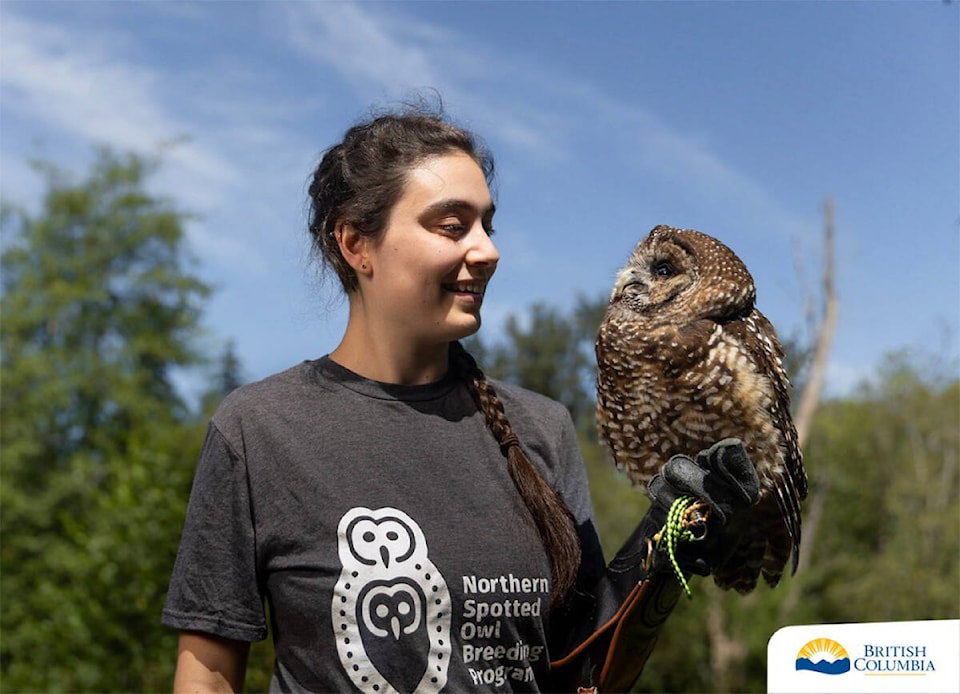The wild B.C. spotted owl population jumped up this summer from just one to four.
The population “explosion” is thanks to a release that took place in Spuzzum in August, deep in the Fraser Canyon. Deemed as an historic milestone for conservation, it was the result of a partnership between the provincial Spotted Owl Breeding and Release Program and Spuzzum First Nation.
“In 1971, a Spô’zêm matriarch was called upon by our Ancestors to tell the story of our much-loved relatives, the skelúleɁ, otherwise known as the Northern Spotted Owl (as named by the settlers of Canada),” said Chief James Hobart of the Spuzzum Nation in a press release. “Our messengers are extremely powerful beings: they are the messengers to our spirit world and of our physical world. They are species that are indicative of the health of an environment. Our matriarch Hrome’Tik’Inquakosen’s artistic documentation of skelúleɁ was instrumental in the preservation of our old growths and the work we are continuing with today for SkelúleɁ’s return into the wild.”
The release, which is a significant step towards an eventual self-sustaining population in B.C., was a carefully planned government-to-government process that incorporated Indigenous knowledge and guidance from Hobart. A detailed assessment of the birds’ readiness was also necessary for their important move, which would see their return to Spuzzum.
The owls were first introduced into protected forests in the Anderson Wildlife Habitat Area and the Spuzzum Wildlife Habitat Area in the Fraser Canyon in early August. Later, they were moved to aviaries in the forest and fed for several days to allow them to get used to hunting in their traditional environment. Eventually, the aviaries were opened so the owls could leave and hunt on their own.
“We are doing everything we can to help spotted owls recover in B.C., including running the world’s only spotted owl breeding and release program for this critically endangered species,” said Josie Osborne, Minister of Land, Water and Resource Stewardship in the press release. “During my visit to the Langley breeding facility in July, I was incredibly impressed by the deep commitment of everyone involved in helping these rare and beautiful birds achieve a self-sustaining population.”
A precondition of the release was the development of feeding skills — the owls needed to demonstrate their ability to capture live prey and maintain a stable body weight. So far, the owls have been successful in hunting and catching their own live prey. The ministry staff also assessed the birds’ health, confirmed that there were no active wildfires in the area, and collaborated with Hobart to ensure that there were no competing owl species, prior to release.
The province has worked with the First Nations in B.C. to protect more than 280,000 hectares of spotted owl habitat in the Cascade region under the Spotted Owl Management Plan — a territory that can support 250 owls. Ministry staff are prepared to help the owls, such as providing supplemental feeding. Spuzzum Nation land guardians and members are also providing support with their knowledge of the health and well-being of the land.
“What I was most proud of is that we’re not sitting here doing nothing, we’re doing something. If we make a mistake, we are making a mistake falling forward,” said Hobart. “I am most excited about hearing back a year from now, or even two months from now, the sounds our SkelúleɁ’s calling in their own woods and realizing they have found their way home, have found themselves…When that next step happens, it will be truly beautiful.”
The program intends to eventually release as many as 20 spotted owls per year. This number is dependent on the continued success of both the breeding program and the returned owls transition to the wild.
Due to the need to safeguard these owls from any outside disturbance, both the media and the general public are not allowed access to the release site until further notice.
READ MORE:
kemone.moodley@hopestandard.com
Like us on and follow us on .



